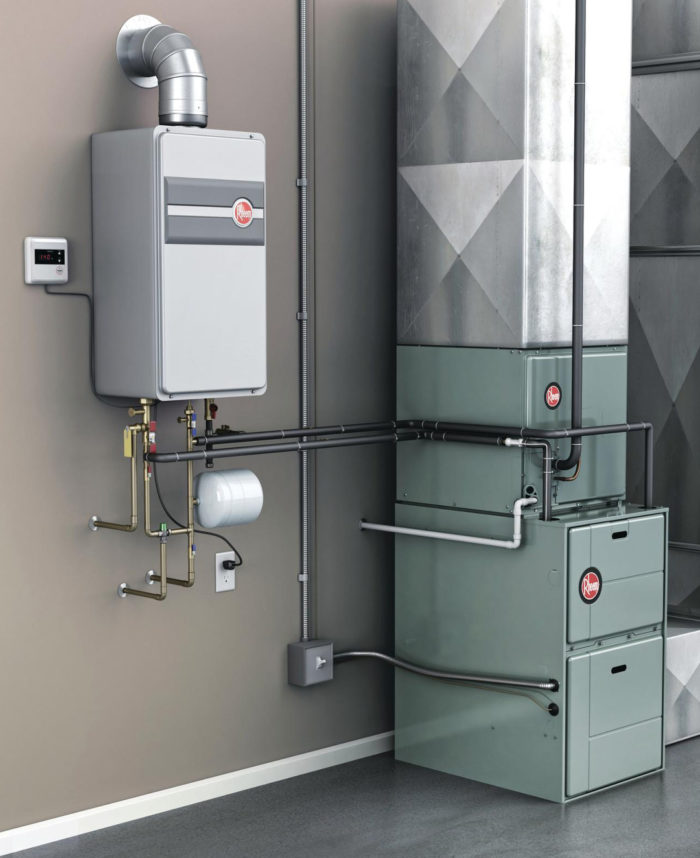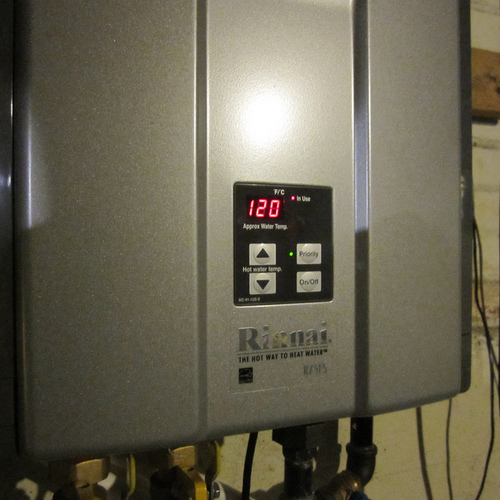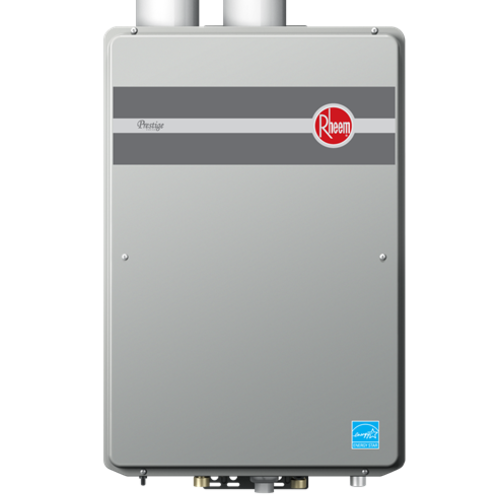
Image Credit: Image #1 and #7: Rheem Manufacturing Co.
You can buy a gas-fired tankless water heater for $600 — or even $300, if you want a bare-bones model. These appliances are remarkable: they are compact enough to hang on a wall and can begin producing an “endless” flow of hot water almost instantly. Many people look at these small appliances and think, “Why can’t I use one to heat my house?”
The answer is, you can. However, just because you can, doesn’t mean you should.
It’s true that a tankless water heater can easily heat most single-family homes. It’s also true that a tankless water heater is smaller and less expensive than a boiler or a furnace. So what’s the catch?
There are several catches, and the issue is fairly complex. The basic problem is that tankless water heaters need a high firing rate — as high as 180,000 BTU/h — to quickly bring cold tap water up to 120°F or 140°F. These appliances work best when the incoming water temperature is relatively low (below 85°F). On the other hand, a space heating appliance for a single-family home or apartment needs a much lower firing rate — usually between 10,000 BTU/h and 20,000 BTU/h — and must be able to tolerate incoming water temperatures that are higher than the temperature of cold tap water.
Trying to use an appliance designed for the instantaneous production of domestic hot water for space heating is possible, but doing so requires the system designer to accept certain compromises and to engage in several contortions.
Before we can analyze the advantages and disadvantages of using a tankless water for space heating, we need to discuss three questions:
Weekly Newsletter
Get building science and energy efficiency advice, plus special offers, in your inbox.

This article is only available to GBA Prime Members
Sign up for a free trial and get instant access to this article as well as GBA’s complete library of premium articles and construction details.
Start Free TrialAlready a member? Log in















19 Comments
What a mess
In 2006 I installed a tankless water heater for both domestic hot water and for my 100 year old cast iron radiator system. What a mess. The heat exchanger kept getting clogged with debris; In winter I never quite new if I was going to be able to have a shower, whether there would be hot water or not. The Rinnai was high maintenance, and sometimes we just couldn't keep the big old drafty barn house above 60°F and would have to huddle around the gas fireplace. Three words: DON"T DO IT!
Thanks for your feedback, Lloyd
Lloyd,
Your experience is typical. This type of system is much easier to screw up than other types of heating systems. Systems with problems can be hard to troubleshoot, turning them into maintenance nightmares -- as your experience illustrates.
Have you solved your problems, or have you installed a new heating system?
So is it proper to say that using a tankless water heater for underfloor heating ONLY will limit the cons of using tankless heaters to the minimum, as I see many of the problems are related to combi systems
DelRizo,
Read my article again. I list many problems with hydronic heating systems that use a tankless water heater for space heating only -- so no, the problems aren't just with combi systems. If you need to make hot water for a hydronic space heating system, use a boiler. If you don't want to use a boiler, you may be able to use a tank-style water heater, but only in some jurisdictions (since using a water heater as a boiler may be a code violation).
And I would never recommend the use of a tankless water heater for a hydronic space heating system.
Thank you Martin, heating is kind of new here in Egypt, trying to get the best of results yet
DelRizo,
That's interesting. My family lived in Beirut in the 1960s, in several different apartments, and they all had central heating -- either hydronic or steam -- with cast-iron radiators. That was common in Lebanon, even 55 years ago.
Yes Martin , Lebanon is way colder than Egypt, anyway thanks alot for you replies and for your article
100 year old radiation needs a real filter (response to Lloyd)
Even if you were installing a modulating condensing boiler, not a tankless you'd need to first treat the system water to deal with the rust and scale (several commercial products are out there) AND you would need more substantial filter than the tiny screen-thingy used in most tankless hot water heaters, including something with a permanent magnet to capture ferrous grit. Many old cast iron boilers have water passages you could pass a rat through, but that's never the case with a mod-con.
And, you'd never want to use an open system with iron radiation, since constant replenishment of system water with fresh water brings fresh oxygen into the system. A fully closed system that's purged annually with fresh water would not have a problem, but open systems require non-corroding plumbing & radiation (like all-PEX in a concrete slab), and bronze impeller pumps.
Flow rates are also an issue for tankless systems. It's far better to set them up with ~2gpm and a high delta-T, independent of the radiation flow requirements. They tolerate fairly extreme temperature deltas compared to the limits of a mod-con boiler, and work more efficiently there.
Reply to Martin
I just downsized and duplexed my house (link below for slideshow) and there was not enough capacity in the Rinnai to service two apartments so I got a new system with a Laars modulating boiler (with really jazzy filters Dana) that has a loop running into a 50 gallon hot water tank. My engineer said it would be fine. Except this system gives the hot water tank priority; when we had the seriously cold snap and it got down to -22°F and my tenant upstairs took a very long shower and emptied the hot water tank, the whole house dropped 10 degrees before it switched back to feed the radiators.
I am now convinced that it is a really bad idea to combine heating with domestic hot water, ever.
http://www.treehugger.com/slideshows/green-architecture/decluttering-and-downsizing-and-renovating-and-actually-surviving/#slide-top
Engineers
They are something Lloyd . Sometimes I wonder about the value of parchment . Just bad design choices or possibly a misunderstanding of mass and how to utilize it . I assume a room by room heat loss calculation was performed as I have seen you on this site many times . Was a survey of the EDR for the existing radiation done and was it considered to lower the water temps and utilize ODR ? If not I question why an engineer would specify a mod con as opposed to a nice 87% AFUE non condensing boiler unless it was strictly for modulation and CAZ reasons .
There are 2 loads with a combi system , the space heating load and the DHW load . The boiler must be sized for the larger of the 2 , if not , you get what happened to you . very unfortunate .
I dunno Lloyd...
The bloggery about the IR imaging directed air sealing was interesting, but it didn't seem like much was really done to reduce the load. You don't have to "...gut the place..." to improve the insulation. Losing 10F of ground on the indoor temps during the course of even a fairly lengthy recovery with 100% of the boiler output serving the tank indicates a painfully lossy house. Even at -22F that shouldn't happen.
Installing the biggest drainwater heat recovery unit that fits downstream of the shower would double the apparent capacity of the indirect hot water tank, and shorten the tank recovery time. But the money might still be better applied to reducing your space heating load with building envelope upgrades. The place is STILL so air-leaky that they can't give you an accurate CFM/50 or ACH/50 number? The18ACH/45 they came up with is still something of an energy emergency in a climate like yours.
http://www.treehugger.com/green-architecture/why-caulking-gun-best-weapon-war-against-energy-waste.html
You can blame the problem on the fact that it's a combined heat & hot water system if you like, but other analysts would place the problem elsewhere.
Giving the hot water heater priority is an option, not a necessity with most zone controllers. Simply setting up the hot water heater without priority over other zones would mitigate most of the problem with losing ground on cold days, and would keep the tenant from taking super-long showers when it's -22F outside. When "sharing" the boiler output with the hot water heaters the radiator output drops as the whole system temperature slowly falls, but it's never even close to zero, the way it can be with a water (ab)user hogging all the boiler output.
I'll quibble somewhat with Richard that the boiler sizing has to change in combi systems to match the higher DHW load (with rare exceptions) when the water is being served by an indirect. The tank has to be sized for the DHW load, but not the burner. But a hot-water-hog can bring this problem to any sized tank if the tank is given priority. If you take away the priority zoning, it will increase the recovery times for the tank when it's cold outside but won't leave you cold.
It may still be worth installing drainwater heat recovery, even if dispensing with the zone priority fixes the problem, ESPECIALLY when you have somebody who can & will deplete a 50 gallon tank during a long shower living there.
Dana
We won't quibble at all . I would never recommend a priority system for a house this leaky . If one required that this strategy be used I recommend against again and if they still stand firm I make sure the equipment is sized appropriately , burner , tank and temps .
with the strategy that is being presently employed however , I would certainly lessen the maximum DHW priority time than what it is now , if for no other reason than to begin to condition the tenant similar to a lab animal . One would hope that this capability has been built into Lloyd's system .
However , I do agree that it is hardly the system or the tech's fault that it is not as effective as it should have been .
I do like the DHRUs also and recommend them often .
Another thought is that the boiler was sized for the load but the amount of system water and the mass of those large diameter pipes was not taken into consideration . A pickup factor should be used when sizing the boiler for systems where these things exist . If those large pipes cool somewhat , then the system water during a long DHW call they will have to heat back up before the installed radiation can give anything to the occupants . Lots of stuff to know , many nuances to varying systems and scenarios . Cannot be taught in a classroom , especially if the guy in front of the room is not aware of stuff like this . Never makes it into the classroom until it is recognized as a problem and that is slow to happen when the engineers just point at the contractor who knows nothing for the lack of parchment .
Navien Combi
You didn't mention Navien in the article. They make ASME certified Combi water heater/space heater units. The plate heat exchanger is built in, plus a circulating pump, and the hydronic part is a closed loop with automatic make-up water. We've used it in combination with a solar hot water system for years and are happy with it so far. The hydronic part is plumbed but we haven't used it yet because the basement isn't yet finished. For all but small systems you also need an external pump, but there are efficient variable speed pumps now with ECM motors that you can use to control the flow rate and reduce electrical usage.The Combi unit has inlets and outlets for both the DHW and hydronic heating, plus the make-up water.
Response to Adam Liberman
Adam,
Actually, I did mention the Navien combi-boiler. Do a search for "Navien" (using Control F) and you'll see it. The mention comes in the section with the sub-head that reads, "More equipment notes."
Reply to Martin
Thanks, I stand corrected!
Tricky design, but can work
I designed and installed an open direct combi system for my house using a Rinnai tankless heater. There are a few things I learned in the process.
1. With an open direct system, the cold water is drawn into the radiant tubing before being used for domestic hot water. During the winter this works great because domestic hot water is more or less instantaneous. To deal with the stagnant water during the summer I've designed the system so the space heating can be isolated from the domestic hot water through a couple of valves. One shuts off supply to the heating loop, the other bypasses the mixing valve, allowing me to lower the set temperature on the water heater to 115F.
2. All parts of the system need to be rated for potable water. That means stainless steel circulator pumps and only copper or PEX with an O2 barrier to reduce the potential for corrosion. If there are any cast iron parts in the system, these need to be isolated with a flat plate heat exchanger and the use of trap filters for iron deposits.
3. I ran into the short-cycling issue until I was able to draw off enough BTUs quickly enough to balance the operating design of the heater with the space heating requirements. Initially I used only PEX-AL-PEX tubing but the heat transfer rate wasn't high enough given the pump size which was had to take domestic and space heating requirements into account. I ended up adding fin radiators to most of the rooms which helped with this problem.
If I were to do it again, I'd use the Navien combi boiler but it didn't exist at the time I designed my system. Fortunately the system is designed in such a way that I could easily swap out the Rinnai with any other heater with minimal reconfiguration. The cost was very low for the system - less than $2000 for all components - but it did take weeks of design and tinkering to get it just right.
Response to Corn Walker
Corn,
Thanks for sharing your story. Your experience -- "weeks of design and tinkering" -- is fairly typical of the stories I've heard.
when I remodeled my home in 2004 I removed the electric baseboard heating and electric hot water heater. i converted whole house to heat about 3500 sq ft living space. I installed a trinity combi gas boiler. what a night mare. after about 4 years i pulled out the Trinity and installed an AO Smith Vertex 100m btu combi gas water heater and 15 years later it's time to replace that. i was considering buying two tankless waterheaters or a conventional water heater for domestic and a tankless for heat. My experience with the combo has not been good. Any thoughts?
Depending on where you are located and your objectives, you could consider moving to heat pumps for some or all of your needs. Also, what fuel are you burning?
Log in or become a member to post a comment.
Sign up Log in